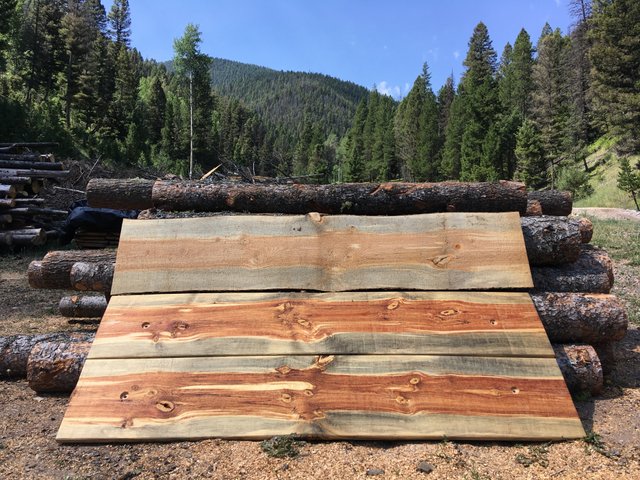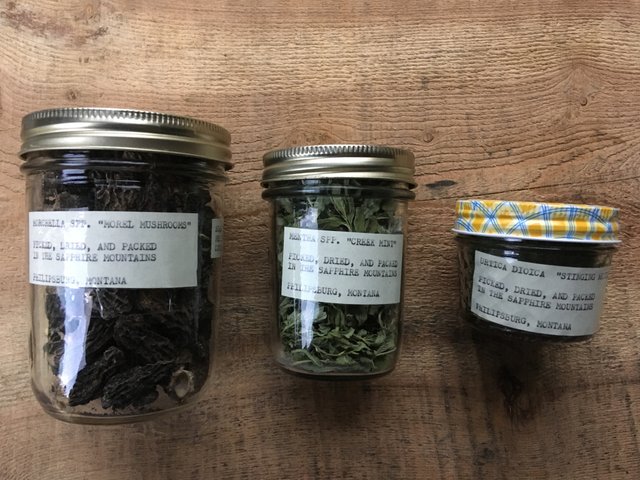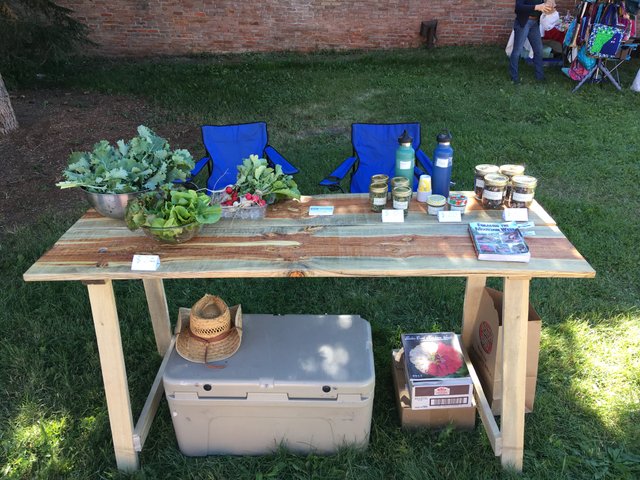The farmer-less market.
There has been a summer-time farmer’s market in Philipsburg for about three-years. It’s a little market situated at one of the only vacant grass lots in the four-block “downtown”, except there is a problem. This particular farmer’s market doesn’t have any farmers…
Since the goal is for our land to make us money rather than us spend money on it, we paid the 10$ set-up fee and figured we’d give it a try. Brandon built an easy-assemble table from the blue-stain pine we milled and have set aside to finish the inside of the cabin. I am sorry I did not photograph the process but it wasn’t anything real special – he just built a table with bolts to take the legs on and off. (The pine with a coat of linseed oil is stunning!)
The morning of the market we spent an hour clipping kale and tying it together in bunches with fishing line. This was made slightly more difficult given the 2C (36F) morning and our fingers were going numb but we persevered. The radish got a quick dip in the tub and bunched together with rubber bands. Lettuce was pulled, roots and all, and sold as individual heads.
We were set-up by 945 for the official start at 1000. Besides us, there were three other tables. One lady selling baked goods, a guy selling slushies and cups, and two older ladies selling quilts and knitted things. We were, and are, the only ones selling produce at the farmers market. There is one fellow that drives from Yakima, WA, with cherries, peaches, and apricots, and sells at various markets but he was not at ours this week. He floats around.
We also had dried morel mushrooms in pint mason jars, mint tea, and nettle tea. These did fairly well and were most of our sales. This does not surprise us as the primary customer-base for the market are tourists walking downtown Sunday morning after staying at one of the bed and breakfasts the night before. We did sell some produce to locals but this was only a handful of items. Tourists bought dried mushrooms and tea that they could take back with them to wherever they came from.
I had a stack of AAL FIREARMS business cards sitting on the table. More than once, after the tourist couple finished asking about the homestead, the wife walked to the quilt tent and the man stayed and talked guns until the wife was finished. I found this the best part of the whole day!
All together the market runs four hours. With no advertising and no history of being there, we showed up and had a total profit of about 50$. All things considered, I am very pleased. Our time isn’t paid much (especially Brandon’s as he does most of the watering) but to know we can make 200$ a month just from selling extra garden clippings and dried forage from the land is really exciting. If times are hard, get creative. Dry mint from the creek. Spread some extra radish seed. Making the “first dollar” from the garden is very inspirational but it also gives feedback.
The fruit guy does very well. The baked goods lady does very well. The guy selling kale and lettuce didn’t do as well.
This is no reason to throw in the towel and stop selling vegetables but it does show where the money is at for the small-scale farmer. Garden vegetables took a decent amount of work watering, clipping, bunching, then required a cooler, ice, and rotating every little while to keep the display units fresh. We have a fruit and nut orchard planned but it will be a while. We bought a dozen trees this spring from a nursery, apples and walnuts. These will start producing in a few years. We also have two dozen apples started by seed and will add more from the nursery each year.
From our observation, the people making money were the ones selling larger-sized, non-refrigerated items. Cherries, peaches, bread, pastries. I suspect things like potatoes, apples, and nuts would do better than kale and lettuce. Things that people can eat on the road, are tasty without preparation, and can be sold week-to-week and sit in a root cellar without spoiling will sell better at our market with our audience. I have no interest in selling sugary sweets. I want to sell healthy things. Just because there is not much money in lettuce doesn’t mean I cannot provide healthy things to locals and tourists.
For the time being, you can expect to find us every Sunday downtown Philipsburg through the summer.
If you are interested in our nettle or “creek mint” tea, or morel mushrooms, I’ll consider shipping out of the area. Before inquiring, please visit your local farmer’s market and see what they have for local produce and dried things!
I want to rant a little on home-gardening. It is saddening to see so many people in this area not growing their own food. I seldom watch movies, but when I do it is usually an old black-and-white film. I was hooked on the Andy Griffith show for a while. Invariably, there is always a garden. Every wife and grandma had an herb basket along the veranda. The husband or grandfather had a potato and corn patch out back. Weeding was part of the children’s chores. Is this not accurate? My grandparents grew up during the depression. They claim everyone had a garden in that time, but when I look around I see almost no gardens – and believe me, I am looking for them! I drive up and down the streets in my small, rural town of 800-people. Hardly even a sunflower.
The year I moved here I asked the librarian what people grew in the area and what did well. She said, and I am paraphrasing, “it’s just too cold here to grow anything”. This is hog-wash. People have been growing foods and domesticating plants for a lot longer than Round-Up ready corn [1] and drought resistant rice [2]. My ancestors were farmers in the mountains of Norway and stayed alive for millennia above the arctic circle. So, “our summers are too short” is not an argument.
On our land, we buy primarily from Baker Creek seeds. [3] They have great options for northern climates. Most of what we grow on the homestead are Siberian varieties. They. Grow. Great.
The soil is sandy in some spots here, but even if all that’s all you have, you can still grow more than sand castles. [4]
“It takes too much time” … “you know, I’m just too busy.” No. This does not hold water. I don’t care if you work 100-hours a week, you can grow something. If you have a lawn, you can have a garden. If you have a window sill, you can grow food.
A few of my neighbors have small gardens. We talk a few times a year about what’s happening, what is growing well, and what we might trade as plants mature. I believe strongly that there is a responsibility to growing your own food. Our food system in America, in almost every city, in almost every way, is very fragile. Less than 1% of the American population farms. [5] I recognize this does not include small, household gardens but this implies that most food production is concentrated. Diesel is required to operate the massive tractors. Computerized tractors are guided by satellite GPS. Refrigerated trucks and trains drive produce hundreds to thousands of miles from origin to supermarket. [6][7] If one train derails. If one truck rolls over. If one hurricane devastates a region, people cannot eat. [8][9] In a previous post documenting my trip to India [10], I was given an apple at breakfast from Washington – half-way around the world even though apples grow all over the Kashmir valley.
You don’t have to be farmer Joe and grow ten acres of wheat. Just grow something. A pot of chives or basil in the kitchen window to start. Then get a five-gallon bucket [11] for $3 from Home Depot and stick a potato in it [12] or buy a tomato start. Throw some radish or lettuce or carrot seed along the fence. It doesn’t take much to gain some kind of food independence. You are the sole individual [13] responsible for your life. [14] Sometimes, especially in disasters [15], you might be all alone. Reinforcements might not come. [16] By starting small, you will gain independence and learn from your mistakes. If the time came where things get really tough, you will have a leg up in the game. Buy cheap seed on sale when stores clear out last-year’s stock for 0.50$ and put it away. Peas from 2016 will still spout. Trust me. Most of my seed was packed in 2011 and is doing just fine.
This article originally appeared on AAL FIREARMS at:
http://aalfirearms.is/20180724-farmer-less-market/
[1] https://www.motherjones.com/food/2015/03/monsanto-herbicide-cause-cancer/
[2] http://irri.org/our-work/research/better-rice-varieties/climate-change-ready-rice
[3] https://www.rareseeds.com/
[4] https://empressofdirt.net/best-vegetables-for-sandy-soils/
[5] https://www.agcensus.usda.gov/Publications/2012/Online_Resources/Highlights/Farm_Demographics/
[6] https://cuesa.org/learn/how-far-does-your-food-travel-get-your-plate
[7] http://msue.anr.msu.edu/news/how_far_did_your_food_travel_to_get_to_you
[8] https://www.huffingtonpost.com/2012/10/31/hurricane-sandy-disrupts-food-distribution_n_2049778.html
[9] https://www.theguardian.com/world/2017/oct/11/puerto-rico-food-shortage-hurricane-maria
[10] http://aalfirearms.is/20180723-kashmir-and-ladakh-india/
[11] https://www.primalsurvivor.net/bucket-gardening/
[12] https://modernsurvivalonline.com/growing-potatoes-in-buckets/
[13] https://thepriceofliberty.org/by-what-legitimate-authority/
[14] https://thepriceofliberty.org/i-carry-a-gun-get-over-it/
[15] https://www.motherjones.com/environment/2009/08/secret-history-hurricane-katrina/
[16] https://www.imdb.com/title/tt0044706/



less market
built an easy-assemble